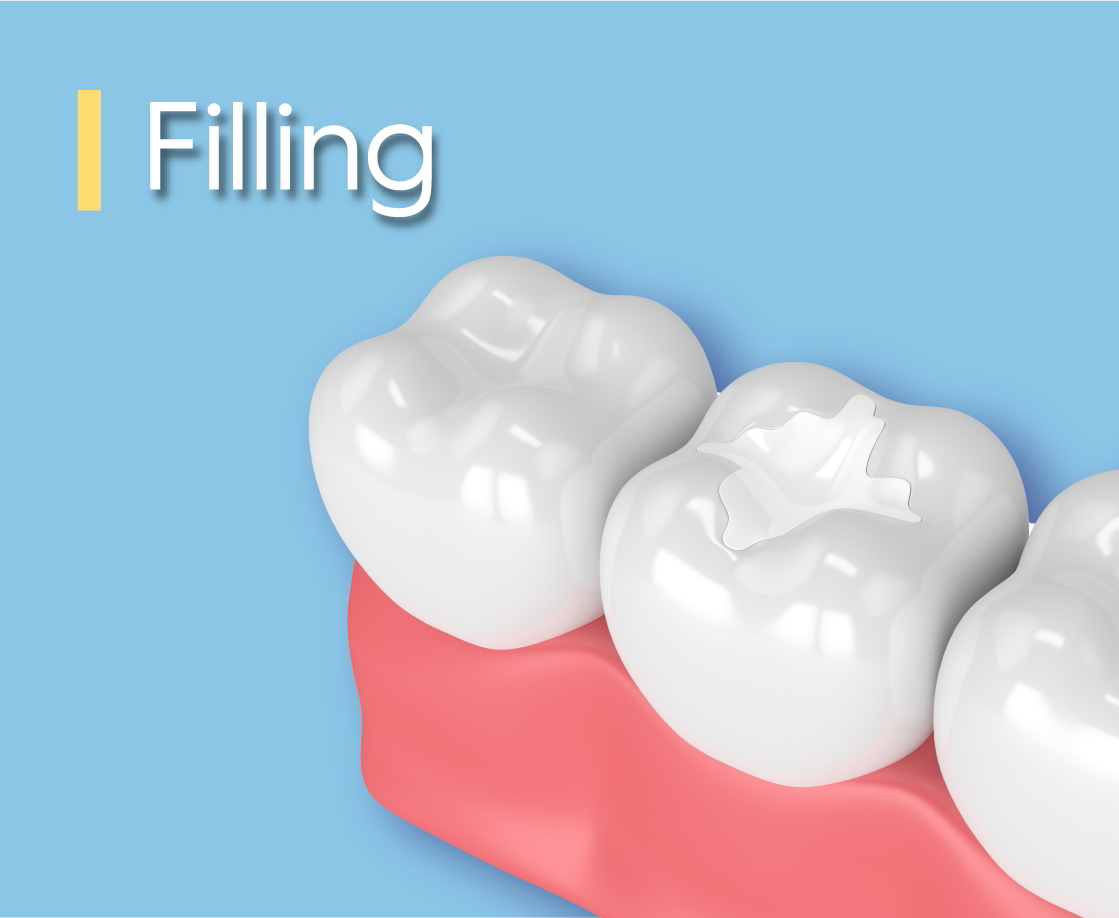

Filling
The process of filling is divided into several steps:

1. Local anaesthesia may be required
2. Remove decayed tooth structure
3. Prepare cavity to appropriate design and shape
4. Fill with suitable materials
5: Trim and polish filling materials
Materials:

Silver Amalgam
With a long history of use as a dental filling for over 150 years, it can restore back teeth where stress load is high. World Health Organization (WHO) and the World Dental Federation (FDI) , as well as other organisations such as the U.S. Food and Drug Administration (FDA), have agreed that amalgam is a safe and effective tooth filling material.
Composition:
A mixture of silver, tin, copper and mercury
Features:
Hard and durable, high wear resistance, safe and easy to use
Disadvantage:
Silver grey, not aesthetically pleasing as a filling material

Procedures:
First, the dentist will remove the decayed part of the tooth, then fill the cavity with amalgam, and finally trim and polish the filling material. During the procedure, local anaesthesia may be required.

Composite Resin
Composite resin fillings are usually made from a mixture of glass and natural tooth-coloured materials. They are now widely used to repair chipped, worn or fractured teeth.
Composition:
A substance made up of acrylic resin filled with inorganic substances such as glass, quartz as additives to enhance the strength
Features:
Aesthetic; colour is similar to that of natural teeth; suitable for front teeth restoration
Disadvantage:
Not as hard as silver amalgam

Procedures:
First, the dentist will remove decayed or weakened portion of the tooth, etch the cavity surface with dilute acid (e.g. 37% phosphoric acid), and then rinse and air-dry the tooth surface. Afterwards, apply dental adhesive on the etched tooth surface, and fill the cavity with composite resin to restore the missing part of the tooth. After that, harden the filling by using a light-curing instrument. Finally, trim off excess material and polish the filling. Local anaesthesia may be required during the procedure.

3 Glass Ionomer
Use on tooth surfaces that are not exposed to heavy chewing force, e.g. outer surface, to restore the abraded part.
Composition:
A substance made up of aluminosilicate glass powder and a liquid polyacrylic acid
Features:
Aesthetic, colour is similar to that of natural teeth, but lack of translucency; bonds to the tooth; fluoride releasing prevents recurrent tooth decay around the filling material
Disadvantage:
Insufficient strength, relatively low wear resistance

Procedures:
The dentist will remove the decayed tooth substances, place the glass ionomer cement onto the prepared tooth, and trim off excessive material and polish the restoration. To increase the strength of glass ionomer cement, acrylic resin is added. For this type of material, light curing is required to harden it after filling the cavity.

Compomer
Composition:
It is a mixture of composite resin and glass ionomer cement.
Features:
Aesthetic, possessing the properties of both composite resin and glass ionomer cement. Better wear resistance than glass ionomer cement; the manipulation is easier than composite
Disadvantage:
Wear resistance not as good as composite

Procedures:
The dentist will remove tooth decay, put a compomer onto the prepared tooth cavity and shape the restoration, then use a light-curing instrument to harden the filling, and finally trim the excessive material off and polish the restoration.
Outcomes:
The purpose of filling is to restore the anatomy and function of the tooth. It can help to preserve the tooth, prevent complications and improve appearance.
Aftercare tips:
- Avoid chewing any hard foods immediately for 3 days after filling.
- You may experience a slight pain after a filling and may wish to observe yourself first. If the pain worsens rather than decreases, please schedule a visit with your dentist.
- Tooth abscess may occur after filling in patients with deep tooth decay in which bacteria may have infected the pulpal tissue and result in Pulp necrosis. The dentist will consider performing an endodontic treatment (root canal treatment) to remove the dead pulp tissue, clean and fill the pulp chamber to preserve the tooth.



 Clinic Location
Clinic Location



